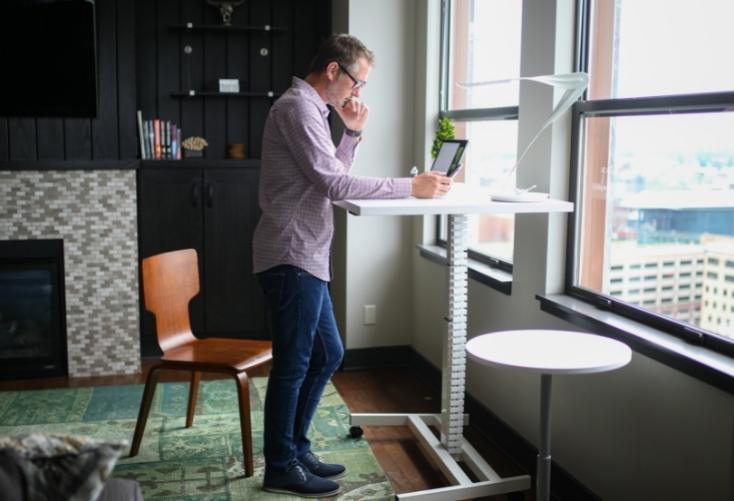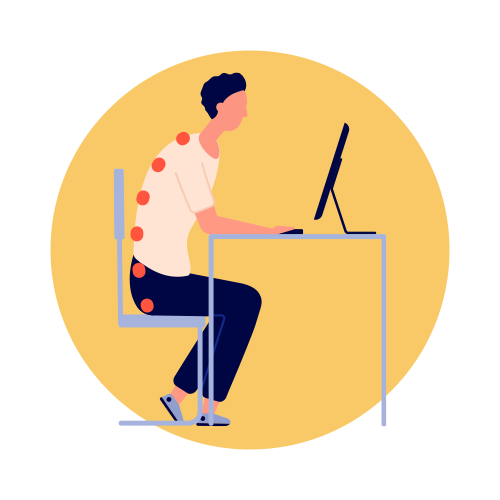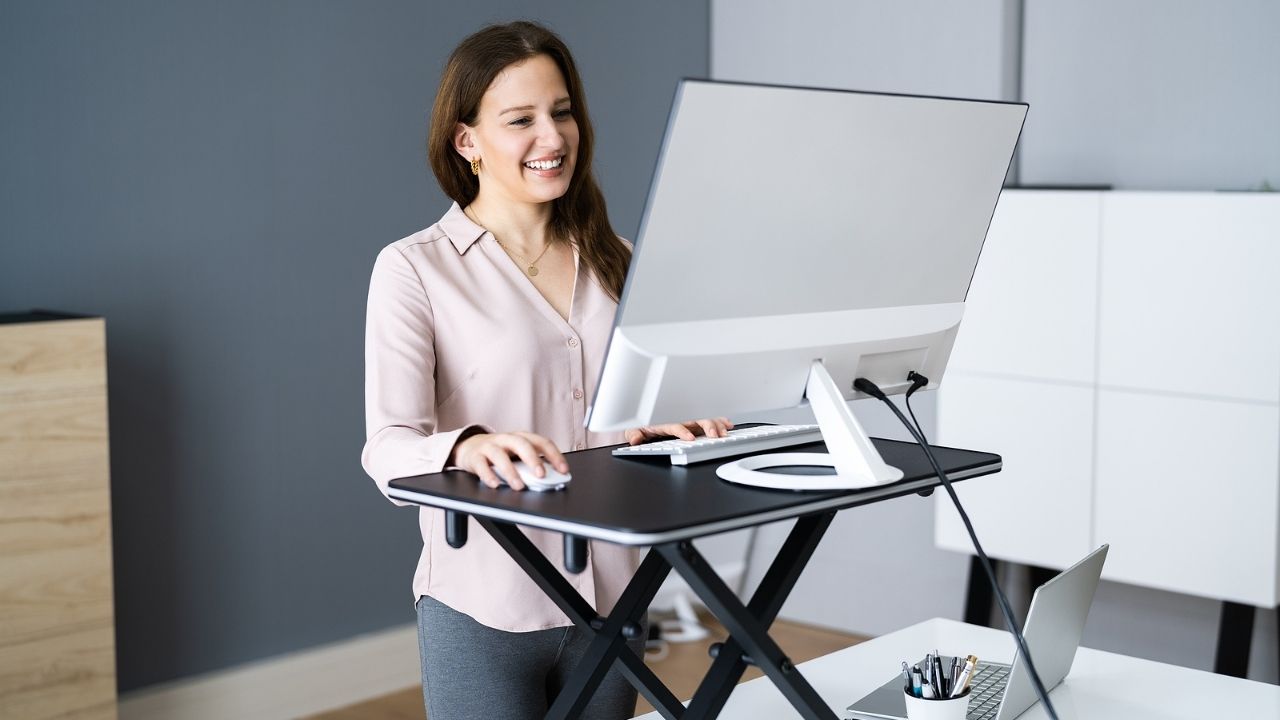More people are working from home than ever before.
These same people aren’t expending energy on the commute or moving around a large office environment like they used to.
Sedentary occupations have risen dramatically over the past 50-60 years. Increasingly, people are sitting for an average of 40+ hours each week.
Despite the rewards that come with working from home, a hyper-sedentary work life can wreak havoc with our health, energy levels and overall sense of wellbeing.
As such, home workers are exploring ways to customize and improve their workspaces. One of their key priorities is to improve the ergonomics of their work environment.
The same goes for office managers, designers and other professionals who are all too aware of the negative impact sitting at a desk all day can have on employee health.
Standing desks have emerged as one of the most popular choices for those who want to improve their workspace. Standing desks raise your computer high enough for you to work and stand at the same time, keeping you on your feet for more of the day.

These days, most standing desks are adjustable, allowing you to split your time between sitting and standing according to your personal preference or the task at hand.
These desks are also called “height adjustable desks” or sit-stand desks”.
Research into standing desks is still in its infancy, but it’s becoming clear that they can have significant health benefits and help negate the adverse effects of sitting all day.
Unsurprisingly, standing desk sales have skyrocketed over the last 12 months as people look for ways to work smarter and healthier.
Yet with so many options out there, choosing a standing desk isn’t always easy. This guide should help you find the right one based on your specific needs.
Why get a standing desk anyway?
The main reason many people choose standing desks is due to the health benefits. Excessive sitting has been linked with higher diabetes and heart disease rates, for instance.
Let’s take a closer look at the research around tasking desks and the following:
- Longevity
- Calories
- Blood sugar
- Back pain
- Moods
- Productivity
1. Longevity

A study published in the American Journal of Epidemiology in 2010 found that standing can have a positive impact on people’s life expectancy.
Women who reported sitting for more than six hours during their leisure time – versus less than three hours a day – had an approximately 40% higher all-cause death rate, and men had an approximately 20% higher death rate.
A separate study concluded that the estimated gains in life expectancy in the US population were two years for reducing excessive sitting to less than three hours a day.
2. Calorie burning

Some experts also believe that sitting for long periods of time contributes to weight gain, because you inevitably burn fewer calories.
While standing burns a handful more calories per hour than sitting, moving around is what really lowers your risk of weight gain and obesity.
3. Lower blood sugar levels

Some studies have linked the use of standing desks to lower blood sugar levels.
One research paper found that following a meal, blood sugar levels returned to normal quicker on the days the participants spent more time standing.
In a study of 10 office workers, standing for 180 minutes after lunch reduced the blood sugar spike by 43%, compared to sitting for the same amount of time.
Both cohorts in the study took the same amount of steps, so the researchers could deduce that the smaller spike was due to standing as opposed to moving around more.
4. Back pain relief

Workers often state that using a standing desk leads to less back pain.
One study concluded that “transitioning from a seated to a standing work posture every 30 minutes across the workday, relative to seated work, led to a significant reduction in fatigue levels and lower back discomfort in overweight/obese office workers.”
Another study found that employees who used a sit-stand workstation experienced a “significant reduction” in existing low back pain.

5. Better moods

Aside from physical health reasons, there are other benefits associated with using a standing desk. In one 7-week study, participants using standing desks reported less stress and fatigue than those who sat down for the whole day.
What’s more, 87% of standing desk users felt they had more energy throughout the day.
6. Increased productivity levels

Studies have shown that standing desks can also boost productivity levels.
One study compared a group of call centre workers who had access to a “stand-capable” desk to a seated group. The experiment involved 167 employees across two departments.
Those using the stand-capable desks were around 45% more productive day-to-day than their seated coworkers.
The productivity of the stand-capable desk users also significantly increased over time, from around 23% in the first month to around 53% over the following six months.
Allwork.Space writer and flexible workspace founder, Jamie Orr, trialled a standing desk while working from home during the pandemic.
She found that she needed to make “some big improvements” to her WFH setup, and “the changing work schedules and needs of my coworking space members has also made me reevaluate how the space can be better designed to help them be more productive.”
“While I still occasionally use the kitchen table for task work, the standing desk has made it much easier for me to be productive when I really need to spend time focusing on projects.
“I have also found that I much prefer the ability to take video calls while standing, which has been an unexpected benefit to upgrading my workspace.”
Are standing desks overrated?
Standing desks are promoted by various health experts. However, most experts also agree that movement is the key to good health.
Researchers publishing in the Journal of Physical Activity and Health provided 74 healthy people with masks measuring oxygen consumption.
They used the data to work out how many calories they burned while working on the computer, watching TV, standing, or walking on a treadmill.

Of course, burning an extra few calories is better than nothing. However, walking is more than twice as beneficial as just standing.
In the absence of walking to the bus stop or up and down the office stairs, perhaps it’s time to get to know your neighbourhood better on your lunch break…
Is standing for 8 hours bad?
Standing all day isn’t recommended.
In fact, some research states that standing all day can increase the risk of cardiovascular disease, mostly because it can result in blood pooling around the leg area. It’s all about achieving a balance by combining sitting with standing.
While some of the benefits of standup desks are exaggerated, they can definitely help reduce back and shoulder pain associated with working while seated.

Is it time to take a stand?
While standing desks are a great choice for a healthy work environment, it’s not a magical solution to all of your health problems. Experts agree that movement is the key.
Throughout the day, you should be taking the time to walk around your home or office.
You can improve your work environment with standing desks, but it’s also important to look at the bigger picture. Encourage yourself and any employees to schedule regular breaks, take the stairs rather than the elevator and get outside if possible.
It’s also important to remember that not all tasks are suited to standing up.
While speaking on the phone or video is relatively easy standing up, writing and drawing tends to be more comfortable and instinctive from a seated position.
Experts seem to agree that the best way to use a standing desk is to stand for a while, sit, then stand again. Do this several times throughout the day. To start, stand for just 30 minutes at a time, a few times a day.
Add an hour, then add two more when you feel comfortable.
It’s important to make sure your body is aligned properly when you use your standing desk. Your head, neck and spine should be in a straight line, your computer monitor at eye level and your elbows at a 90-degree angle with your wrists placed on the desk.
Make sure you wear comfortable shoes and avoid high heels. If you require more support, you can always stand on a cushioned mat.
But above all, be sure to integrate exercise into your day.


 Dr. Gleb Tsipursky – The Office Whisperer
Dr. Gleb Tsipursky – The Office Whisperer Nirit Cohen – WorkFutures
Nirit Cohen – WorkFutures Angela Howard – Culture Expert
Angela Howard – Culture Expert Drew Jones – Design & Innovation
Drew Jones – Design & Innovation Jonathan Price – CRE & Flex Expert
Jonathan Price – CRE & Flex Expert













